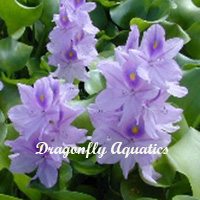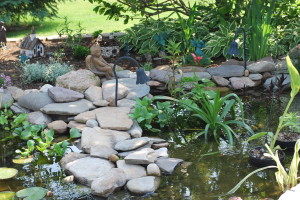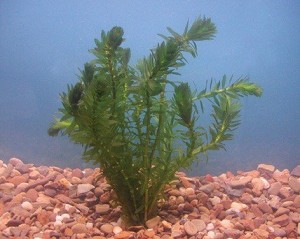Cooler temperatures are the thing again with a slight freeze in Ohio. I tend to feel drained when the days are rainy but that sunshine sure makes one feel good again! We turned the garden over this week and that's the last of the tomatoes until next year. I do really enjoy the garden and the benefits of enjoying the fresh vegetables all winter long but it keeps one busy during the month of August. Now its apple time....I like making the fresh applesauce and putting away a few whole apples for the apple crisp and pies. There's nothing better than a warm apple crisp on a cold winter day.
Let's face it....there isn't much to do with the pond now that summer is ending and things are put to bed. I pulled all the water hyacinths out last week. Trimmed up the lilies and took all the tropical waterlilies and put them to bed in the greenhouse for the winter. I still have to drop the hardy waterlilies but some are still blooming so I'll wait awhile yet. My cardinal flower is still standing tall and I must say this has been its best year yet! I had at least 7 flowers on it and the hummingbirds sure were happy!!
I'm not certain of the identity of this butterfly. I thought perhaps it was a male Eastern Tiger Swallowtail. I'm really not certain, although it sure liked my dwarf crab-apple tree. It came back day after day.....I'm thinking it was the same one.
I know we don't want to think about it but it won't be long and fall will be here and we all know what comes next.....its time for us to be thinking about taking the extra care with our pond plants to make them comfortable for the winter cold. I've noticed the butterflies aren't as plentiful as they had been but occassionally I'm able to catch one.
HARDY BOG/MARGINAL PLANTS
Once your hardy marginal plants begin to brown, usually after the first hard frost, prune back excess foliage and discard any decaying material, so it does not compromise the water quality over the winter months. Potted bog plants such as Pickeral, Thalia Dealbata, and Japanese Variegated Iris should be placed at a sufficient depth to avoid freezing the crown of the plant. Most of the other hardy bog plants can be left as they are and will return the following spring.
Tropical Bog Plants
Many of the tropical bog plants will winter well indoors in a sunny window or with a grow light. They do not need to be submerged in water. Keep the soil constantly moist by placing the potted plants in a tray of water.
 Floating plants such as Water Hyacinth and Water Lettuce are considered tropical and will not survive temperatures below freezing. After the first hard frost, remove them from the pond to prevent them from decaying and adding unwanted debris to the pond.
Floating plants such as Water Hyacinth and Water Lettuce are considered tropical and will not survive temperatures below freezing. After the first hard frost, remove them from the pond to prevent them from decaying and adding unwanted debris to the pond.
Trying to winter them over indoors is difficult. They need to be kept in an aquarium or floated in anything that can hold water. The problem is they lack adequate light intensity. They seem to do well for awhile but by February when they start to grow the natural light is not bright enough to promote proper growth. The water temps need to be at least 70 degrees and they need at least 14 hours of sunlight or equivalent to four fluorescent bulbs held about 12 inches over the water.
When you consider the amount of energy and electricity needed to keep tropical plants alive over the winter its probably cheaper to just use them for mulch in your vegetable garden and buy new ones in the spring.
 Some of you further north of us, are already getting some chilly nights. The leaves on your trees are already showing the colors of fall. Here, in Ohio things are just beginning to change. In the past week, I've noticed a few splotches of color. Before the leaves begin to fall, cover your pond with one of our pond covers. The goal is to try and keep the pond as clean as possible for the winter months. Leaves will sink to the bottom of the pond and rot, causing excess carbon dioxide and hydrogen sulfide. After the first frost, take out any floating plants, as these will begin to decay. Trim back hardy lilies and place below the freeze line. Trim foliage back on your hardy bog plants. Not all bog plants need to be submerged, some will be fine where they are. Check out each plants individual needs to ensure they re-appear in the spring for you.
Some of you further north of us, are already getting some chilly nights. The leaves on your trees are already showing the colors of fall. Here, in Ohio things are just beginning to change. In the past week, I've noticed a few splotches of color. Before the leaves begin to fall, cover your pond with one of our pond covers. The goal is to try and keep the pond as clean as possible for the winter months. Leaves will sink to the bottom of the pond and rot, causing excess carbon dioxide and hydrogen sulfide. After the first frost, take out any floating plants, as these will begin to decay. Trim back hardy lilies and place below the freeze line. Trim foliage back on your hardy bog plants. Not all bog plants need to be submerged, some will be fine where they are. Check out each plants individual needs to ensure they re-appear in the spring for you.
Get your pond cover, de-icers here.
 Well, I personally do not want to believe it.....but, the calendar does not lie! It's September 21st, and fall is scheduled to arrive tomorrow. With that being said, there are some things you will want to do to ensure your pond and aquatic inhabitants survive the Winter ahead. Before winter arrives, you will want to make sure your pond and filtering system are clean to ensure good water quality throughout the winter months. With the arrival of fall it is wise to do a partial water change to remove any built up contaminants to improve water quality. Partial water changes need to be made before water temperatures fall below 60 degrees to minimize fish stress. Adding pond salt at this time will improve the slime coating of your fish, to help them ward off disease and parasites.
Well, I personally do not want to believe it.....but, the calendar does not lie! It's September 21st, and fall is scheduled to arrive tomorrow. With that being said, there are some things you will want to do to ensure your pond and aquatic inhabitants survive the Winter ahead. Before winter arrives, you will want to make sure your pond and filtering system are clean to ensure good water quality throughout the winter months. With the arrival of fall it is wise to do a partial water change to remove any built up contaminants to improve water quality. Partial water changes need to be made before water temperatures fall below 60 degrees to minimize fish stress. Adding pond salt at this time will improve the slime coating of your fish, to help them ward off disease and parasites.
 As long as the submerged plants are below the ice, they will usually survive the winter in most zones. Any part of the plant that is allowed to freeze will turn to mush and add unwanted debris to the pond. It is wise to cut these plants back.
As long as the submerged plants are below the ice, they will usually survive the winter in most zones. Any part of the plant that is allowed to freeze will turn to mush and add unwanted debris to the pond. It is wise to cut these plants back.